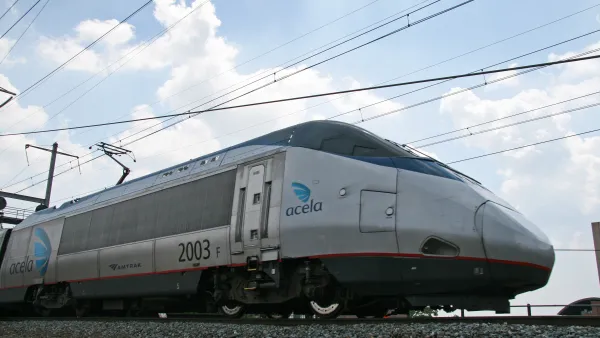Acela has improved connectivity along the Northeast Corridor, but is that actually a good thing? Aaron M. Renn argues that high-speed rail has actually hurt America by giving the finance industry a stranglehold over fiscal and monetary policies.
"I think it's very clear that transportation networks have vast impact on the structure of society, not just how people and goods get from Point A to Point B," says Renn. He acknowledges the success of Acela in closely linking Boston, New York, and Washington, but believes that the shrinking distance between Wall Street and K Street has been unhealthy for America. "During the financial crisis, the government and the Fed have kept Wall Street well supplied with bailouts and nearly free access to capital that allows them to literally print risk free profits by recycling in the free loans into interest bearing government debt," Renn explains, "all while Main St. businesses and homeowners have borne the full brunt of a credit crunch, state and local governments fiscally starve, and infrastructure funds dry up."
The geographic proximity of New York to Washington facilitates the imbalance of the finance industry while allowing insiders to obtain "a near lock on the position of Treasury Secretary" and letting figures responsible for financial meltdowns go free. "Indeed, advocates of high speed rail boast of the positive transformational effects of HSR as one of the reasons to build it. But was with the interstate highway system, we need to be aware of the hidden risks as well," cautions Renn. "The Acela is perhaps living proof that high speed rail can reshape America. It is literally helping rewrite the geographic power map of America. Unfortunately, at this point don't think that's been a good thing."
FULL STORY: Is The Acela Killing America?

National Parks Layoffs Will Cause Communities to Lose Billions
Thousands of essential park workers were laid off this week, just before the busy spring break season.

Retro-silient?: America’s First “Eco-burb,” The Woodlands Turns 50
A master-planned community north of Houston offers lessons on green infrastructure and resilient design, but falls short of its founder’s lofty affordability and walkability goals.

Delivering for America Plan Will Downgrade Mail Service in at Least 49.5 Percent of Zip Codes
Republican and Democrat lawmakers criticize the plan for its disproportionate negative impact on rural communities.

Test News Post 1
This is a summary

Test News Headline 46
Test for the image on the front page.

Balancing Bombs and Butterflies: How the National Guard Protects a Rare Species
The National Guard at Fort Indiantown Gap uses GIS technology and land management strategies to balance military training with conservation efforts, ensuring the survival of the rare eastern regal fritillary butterfly.
Urban Design for Planners 1: Software Tools
This six-course series explores essential urban design concepts using open source software and equips planners with the tools they need to participate fully in the urban design process.
Planning for Universal Design
Learn the tools for implementing Universal Design in planning regulations.
EMC Planning Group, Inc.
Planetizen
Planetizen
Mpact (formerly Rail~Volution)
Great Falls Development Authority, Inc.
HUDs Office of Policy Development and Research
NYU Wagner Graduate School of Public Service




























